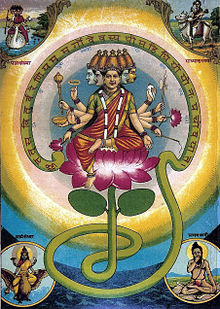Gayatri: Difference between revisions
added Category:Names of God in Hinduism using HotCat |
No edit summary |
||
| Line 37: | Line 37: | ||
* [[Upanayanam]] |
* [[Upanayanam]] |
||
* [[Saraswati]] |
* [[Saraswati]] |
||
==[http://www.shaligram.com/Exotic_Bhur_Bhuvas_Gayatri_Shaligram-322.htm Gayatri Maa Shaligram Shila]== |
|||
The powerful Bhoor Bhavas Gayatri Shila glitters like diamonds and gems, has white shinning crytals/sphatik and has golden coloured impressions inside is considered extremely auspicious, immensely powerful and the ultimate Shila for achieving Salvation or Moksha and all worldly pleasures. |
|||
==Notes== |
==Notes== |
||
Revision as of 05:50, 5 August 2013

This article needs additional citations for verification. (January 2010) |
Gayatri (Sanskrit: गायत्री, gāyatrī) is the feminine form of gāyatra, a Sanskrit word for a song or a hymn, having a Vedic meter of 3 padas or lines of 8 syllables. In particular it refers to the Gayatri mantra, and the Hindu goddess Gayatri as that mantra personified.
Portrayal
Gayatri is typically portrayed as seated on a red lotus, signifying wealth. She appears in either of these forms:
- Having five heads with the ten eyes looking in the eight directions plus the earth and sky, and ten arms holding all the weapons of Lord Shiva, Lord Vishnu & Lord Brahma.
- Accompanied by a white swan, holding a book to portray knowledge in one hand and a cure in the other, as the goddess of Education.[citation needed]
She is an aspect of Mata Saraswati, Mata Lakshmi & Mata Parvati, all three in one form, a form of Adi Shakti, possessing the Rajasi Guna and hence is the source of Brahma's power. Without her, Brahma remains dormant or unable to create.[citation needed]
Hymns
Recitation of the Gayatri Mantra is preceded by oṃ (ॐ) and the formula bhūr bhuvaḥ svaḥ (भूर् भुवः स्वः), known as the mahāvyāhṛti ("great utterance"). This prefixing of the mantra proper is described in the Taittiriya Aranyaka (2.11.1-8), which states that scriptural recitation was always to begin with the chanting of the syllable oṃ, followed by the three Vyahrtis and the Gayatri verse.[1] Following the mahāvyāhṛti is then the mantra proper, the verse RV 3.62.10:
|
<! Whereas in principle the gāyatrī metre specifies three pādas of eight syllables each, the text of the verse as preserved in the Rigveda Samhita is one syllable short, the first pāda counting seven instead of eight. Metrical restoration would emend the attested tri-syllabic vareṇyaṃ with a tetra-syllabic vareṇiyaṃ.[2]

In popular culture
During the year 2003-04, a series based on the mythological stories of Goddess Gayatri was aired on Doordarshan, the national TV channel of India on prime time (10 AM, Sunday). Serial also included biography of Pt. Shriram Sharma Acharya, founder of All World Gayatri Pariwar.
See also
The powerful Bhoor Bhavas Gayatri Shila glitters like diamonds and gems, has white shinning crytals/sphatik and has golden coloured impressions inside is considered extremely auspicious, immensely powerful and the ultimate Shila for achieving Salvation or Moksha and all worldly pleasures.
Notes
- ^ Carpenter, David Bailey; Whicher, Ian (2003). Yoga: the Indian tradition. London: Routledge. p. 31. ISBN 0-7007-1288-7.
{{cite book}}: CS1 maint: multiple names: authors list (link) - ^ B. van Nooten and G. Holland, Rig Veda. A metrically restored text. Cambridge: Harvard Oriental Series (1994).[1]
Further reading
- Gayatri Mahavigyan The Most And the best Book for understanding Ma gayatri.http://pustak.org/home.php?bookid=4272 [2]
you can read the book online by http://literature.awgp.org/books [3]
- Sacinandana Swami: The Gayatri Book., Vasati Verlag, 2005, ISBN 978-3-937238-05-0
- "Gayatri Sahasranam", Swami Satyananda Saraswati, Devi Mandir (ISBN 1-877795-57-7)
- Sadguru Sant Keshavadas (1978,2006). Gayatri: The Highest Meditation. Dehli: Motilal Bandarsidass Publishers PVT. LTD. pp. 148 pages. ISBN 81-208-0697-2.
{{cite book}}: Check date values in:|year=(help)CS1 maint: year (link) [4]

